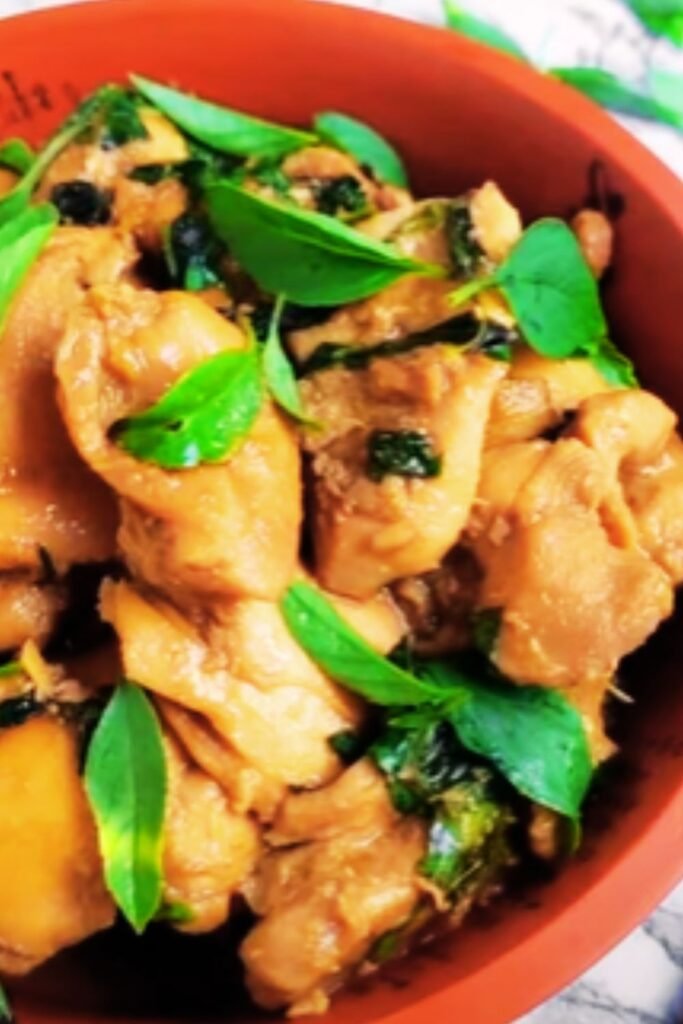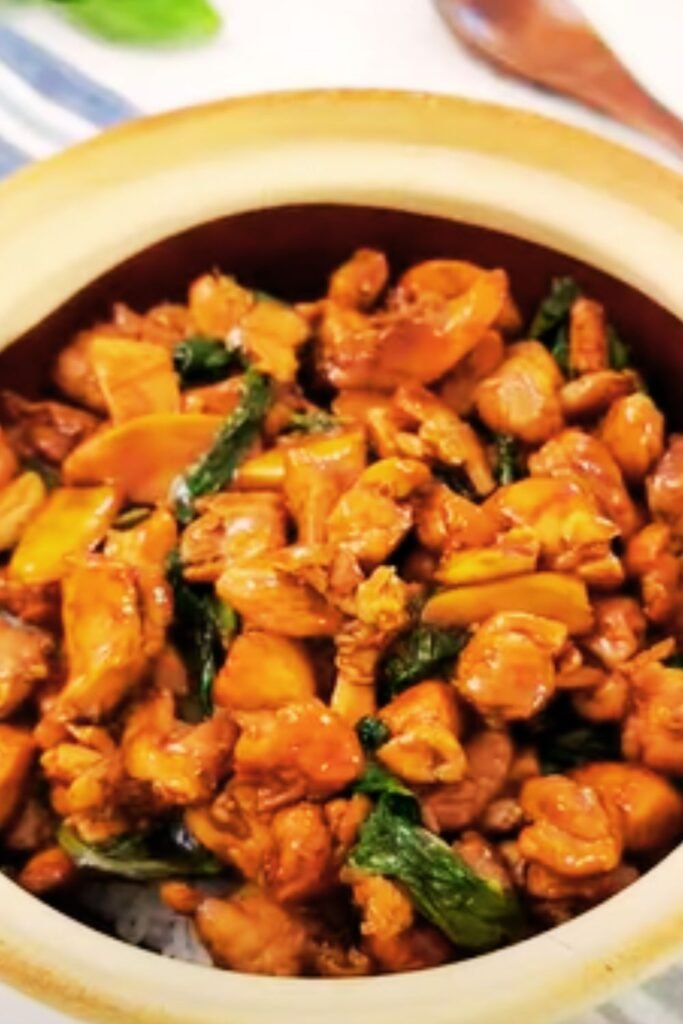When I first encountered Three Cup Chicken at a bustling night market in Taipei, I had no idea this humble dish would become my go-to comfort food recipe. The aroma alone – that intoxicating blend of sesame oil, soy sauce, and fresh basil – stopped me in my tracks. One bite of the glossy, caramelized chicken with its perfect balance of salty, sweet, and aromatic flavors, and I knew I had to master this dish.
Three Cup Chicken, or San Bei Ji (三杯雞) in Mandarin, represents everything I love about Taiwanese cuisine: simple ingredients transformed into something extraordinary through technique and tradition. This isn’t just another chicken recipe – it’s a culinary philosophy that proves the magic happens when you respect each component and let them work together harmoniously.
What Makes Three Cup Chicken Special
The beauty of San Bei Ji lies in its deceptive simplicity. At its core, this dish uses just three liquid components – hence the name “three cups.” But don’t let that fool you into thinking it’s basic. The interplay between these elements creates layers of flavor that develop and intensify as the dish cooks, resulting in chicken that’s both deeply savory and surprisingly complex.
What sets this apart from other braised chicken dishes is the cooking method. Unlike Western braising where ingredients simmer in liquid, Three Cup Chicken uses a reduction technique that concentrates flavors while creating that signature glossy, almost lacquered appearance on the chicken pieces.
Understanding the “Three Cups” – Key Ingredients Breakdown
Traditional Three Cups:
- Sesame Oil (麻油): Provides the nutty, aromatic base that’s essential to authentic flavor
- Soy Sauce (醬油): Adds umami depth and the characteristic dark color
- Rice Wine (米酒): Contributes sweetness and helps tenderize the chicken
Modern Adaptations:
- Dark Soy Sauce: For color and deeper flavor
- Light Soy Sauce: For saltiness without overpowering
- Shaoxing Wine: Premium rice wine that elevates the dish
Essential Ingredients and Their Roles
| Ingredient | Quantity | Purpose | Substitutions |
|---|---|---|---|
| Chicken (bone-in pieces) | 2-3 lbs | Main protein, bone adds flavor | Thighs, drumsticks, or whole cut-up chicken |
| Sesame Oil | 1/3 cup | Aromatic base, authentic flavor | Toasted sesame oil preferred |
| Soy Sauce (light) | 1/3 cup | Primary seasoning | Low-sodium available |
| Rice Wine/Shaoxing Wine | 1/3 cup | Tenderizing, sweetness | Dry sherry in pinch |
| Fresh Ginger | 2-inch piece | Aromatic foundation | Never substitute dried |
| Garlic | 6-8 cloves | Flavor base | Fresh only |
| Thai Basil | 2 cups fresh | Signature aroma and taste | Holy basil preferred, sweet basil acceptable |
| Rock Sugar | 2-3 pieces | Balances saltiness, creates glaze | Brown sugar or palm sugar |
| Dried Chilies | 3-4 pieces | Heat and color | Adjust to taste |

My Foolproof Three Cup Chicken Recipe
After making this dish countless times and tweaking it to perfection, here’s my version that delivers restaurant-quality results every time.
Preparation Steps
Chicken Preparation:
- Pat chicken pieces completely dry with paper towels
- Cut into 2-inch pieces if using whole chicken
- Let come to room temperature for 30 minutes before cooking
Aromatics Preparation:
- Slice ginger into thick coins (don’t peel for more intense flavor)
- Smash garlic cloves with flat side of knife, then rough chop
- Remove stems from dried chilies, shake out most seeds
Basil Preparation:
- Wash Thai basil leaves gently and pat dry
- Remove from stems just before adding to dish
- Reserve some leaves for garnish
Cooking Process
Step 1: Building the Flavor Base Heat your wok or heavy-bottomed pot over medium-high heat. Add sesame oil – you’ll know it’s ready when it shimmers and becomes fragrant. This initial heating activates the sesame oil’s nutty compounds, which is crucial for authentic flavor.
Add ginger slices first, letting them sizzle for 30 seconds until aromatic. Follow with garlic and dried chilies, stirring constantly to prevent burning. The kitchen should smell incredible at this point.
Step 2: Searing the Chicken Increase heat to high and add chicken pieces skin-side down. Don’t overcrowd – work in batches if necessary. Let the chicken sear undisturbed for 3-4 minutes until golden brown. This initial searing creates the foundation for the dish’s complex flavors.
Flip chicken and sear the other side for another 3 minutes. The chicken doesn’t need to be fully cooked at this stage – we’re building layers of flavor.
Step 3: The Three Cup Addition Reduce heat to medium and add the rice wine first – it should sizzle dramatically. Follow immediately with light soy sauce, then dark soy sauce if using. The liquid should come about halfway up the chicken pieces.
Add rock sugar pieces, nestling them between chicken pieces. The sugar will gradually dissolve and create the characteristic glaze.
Step 4: The Braising Magic Bring the mixture to a gentle boil, then reduce to a simmer. Cover and cook for 20 minutes, turning chicken pieces halfway through. The liquid should reduce by about half during this time.
Remove the lid and increase heat to medium-high. Continue cooking, turning chicken pieces occasionally, until the sauce becomes thick and glossy – about 10-15 minutes more.
Step 5: The Basil Finish When the sauce coats the chicken like a glaze, add fresh Thai basil leaves. Stir gently just until the basil wilts and releases its aroma – this takes less than a minute.

Nutritional Information and Health Benefits
| Nutrient | Per Serving (4 servings total) | Daily Value % |
|---|---|---|
| Calories | 385 | 19% |
| Protein | 32g | 64% |
| Total Fat | 18g | 23% |
| Saturated Fat | 5g | 25% |
| Sodium | 1,240mg | 54% |
| Carbohydrates | 8g | 3% |
| Sugar | 6g | – |
| Iron | 2.1mg | 12% |
| Vitamin A | 380 IU | 8% |
Health Benefits:
- High Protein Content: Supports muscle maintenance and growth
- Sesame Oil: Contains healthy unsaturated fats and antioxidants
- Ginger: Anti-inflammatory properties and digestive benefits
- Garlic: Immune system support and cardiovascular benefits
- Thai Basil: Rich in antioxidants and essential oils
Serving Suggestions and Pairings
Three Cup Chicken shines brightest when served family-style with complementary dishes that balance its rich, intense flavors.
Perfect Rice Companions:
- Steamed jasmine rice (my personal favorite)
- Brown rice for added nutrition
- Taiwanese red rice for authentic presentation
- Coconut rice for a subtle sweet contrast
Vegetable Sides:
- Stir-fried bok choy with garlic
- Taiwanese-style blanched vegetables with sesame oil
- Cucumber salad with rice vinegar dressing
- Steamed Chinese broccoli
Soup Pairings:
- Simple miso soup
- Clear chicken broth with winter melon
- Tomato egg drop soup
Regional Variations and Adaptations
Jiangxi Province Original: The birthplace version uses more rice wine and often includes additional aromatics like star anise. Some families add a touch of black vinegar for complexity.
Taiwanese Night Market Style: Street vendors often add a splash of Taiwan beer during cooking and serve with pickled vegetables on the side.
Modern Fusion Approaches:
- Korean-Inspired: Add gochujang for heat and umami depth
- Thai Fusion: Include lemongrass and fish sauce
- Vegetarian Version: Replace chicken with firm tofu or king oyster mushrooms
Troubleshooting Common Issues
Problem: Sauce Too Salty Solution: Add a bit more rice wine and a pinch of sugar. Dilute with chicken stock if necessary.
Problem: Chicken Tough or Dry Solution: Use bone-in, skin-on pieces and don’t overcook. Dark meat works better than breast meat.
Problem: Sauce Won’t Thicken Solution: Increase heat and cook uncovered longer. The reduction process can’t be rushed.
Problem: Basil Turns Black Solution: Add basil at the very end and remove from heat immediately after stirring.
Storage and Reheating Tips
Three Cup Chicken actually improves with time as the flavors meld together. Store leftovers in the refrigerator for up to 4 days or freeze for up to 3 months.
Reheating Methods:
- Stovetop: Gentle reheat with a splash of water or rice wine
- Microwave: Use 50% power to prevent overcooking
- Oven: Cover and reheat at 325°F until warmed through

Cultural Significance and History
Three Cup Chicken carries deep cultural meaning beyond its delicious taste. Legend attributes its creation to Wen Tianxiang, a Song Dynasty poet and general who was imprisoned by the Yuan Dynasty. Before his execution, he supposedly created this dish as a final meal, symbolizing his unwavering loyalty to his homeland.
Whether or not this story holds historical accuracy, it reflects the dish’s significance in Chinese culture as a symbol of home, tradition, and the power of simple ingredients to create something meaningful.
In Taiwan, San Bei Ji represents the island’s unique culinary identity – taking mainland Chinese techniques and ingredients, then adapting them with local preferences and ingredients like Thai basil, which isn’t traditional in Chinese cooking but has become essential to the Taiwanese version.
Tips for Perfect Results Every Time
Ingredient Quality Matters:
- Use the best sesame oil you can find – it makes a noticeable difference
- Fresh Thai basil is non-negotiable for authentic flavor
- Choose chicken pieces with skin and bones for maximum flavor
Technique Details:
- Don’t skip the initial searing – it creates crucial flavor compounds
- Let the sauce reduce properly – patience yields better results
- Taste and adjust seasoning throughout the cooking process
Equipment Recommendations:
- A good wok or heavy-bottomed pot distributes heat evenly
- Have a splatter screen handy – sesame oil can get messy
- Use wooden utensils to avoid scratching non-stick surfaces
Questions and Answers
Q: Can I make Three Cup Chicken without rice wine? I don’t recommend omitting the rice wine entirely, as it’s crucial for authentic flavor and helps tenderize the chicken. If you can’t find rice wine, dry sherry makes an acceptable substitute, though the flavor will be slightly different.
Q: What’s the difference between Thai basil and regular basil in this dish? Thai basil has a more intense, slightly spicy flavor with hints of anise that’s essential to authentic Three Cup Chicken. Regular sweet basil can work in a pinch, but the dish won’t have that distinctive aroma and taste that makes it special.
Q: Can I use boneless chicken for this recipe? While you can use boneless chicken, I strongly recommend bone-in pieces. The bones add incredible flavor to the sauce and help prevent the meat from drying out during the braising process. If you must use boneless, reduce the cooking time significantly.
Q: How do I know when the sauce is properly reduced? The sauce is ready when it coats the chicken pieces like a glossy glaze and you can draw a clear line through it with your spoon that doesn’t immediately fill back in. It should be thick enough to cling to the chicken but not so thick that it becomes sticky.
Q: Can I make this dish ahead of time? Absolutely! Three Cup Chicken actually tastes better the next day as the flavors have more time to meld. Just don’t add the fresh basil until you’re ready to serve, and add a splash of rice wine when reheating to refresh the flavors.
Q: Is there a way to make this dish less salty? If you’re watching your sodium intake, use low-sodium soy sauce and reduce the quantity slightly. You can also dilute the sauce with a bit of chicken stock or water, though this will affect the final texture. Remember that this dish is traditionally quite flavorful and meant to be eaten with plain rice.
Q: What should I do if I can’t find rock sugar? Brown sugar or palm sugar work as substitutes, though they’ll add different flavor notes. Use about half the amount since these sugars are typically sweeter than rock sugar. You can also use regular granulated sugar, but add it gradually and taste as you go.
Q: Can I double this recipe for a larger crowd? Yes, but use a larger pot to ensure even cooking. You may need to sear the chicken in batches to avoid overcrowding. The cooking time might increase slightly, so monitor the sauce reduction carefully.
This beloved dish represents everything wonderful about home cooking – simple ingredients, time-honored techniques, and the kind of deeply satisfying flavors that bring people together around the dinner table. Whether you’re cooking for family or friends, Three Cup Chicken delivers comfort and connection in every single bite.